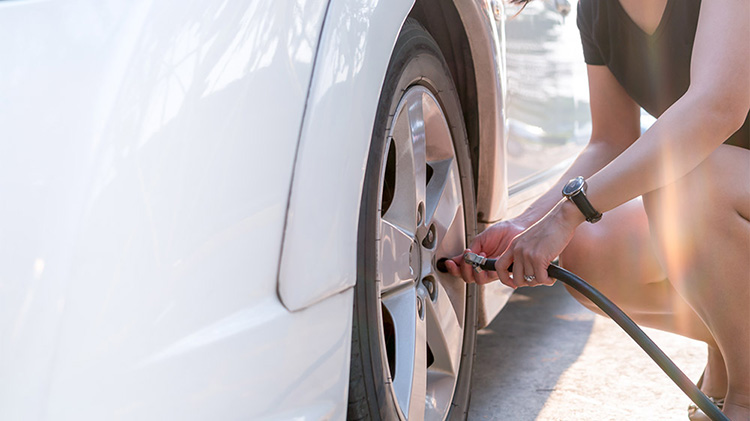Winter car tips
Help prepare your car for the winter season with these winter car care tips.
Getting your vehicle ready for winter’s icy road conditions can be essential for the safety and performance of your vehicle during the colder months. Properly winterizing a car can help prevent breakdowns and accidents, possibly saving you from the inconvenience and danger of being stranded in the cold.
Winter car maintenance tips
Plan to winterize your car before the first storm of the season. Consider checking or talking to your mechanic about the following:
Service your vehicle and do a maintenance inspection
This can include checking your car's fluids such as engine oil, antifreeze and windshield washer fluid to help ensure they're at the right levels and appropriate for low temperatures. Check that your brakes are in good working order, as stopping distances can increase on icy roads. See that your hoses and belts are working properly, as cold temperatures can make them brittle and more prone to breaking. The hoses and belts help keep your engine running, so confirm there are no cracks or signs of wear and tear.
Look at your vehicle’s battery strength
Cold weather can take a toll on your car’s battery. Battery capacity decreases significantly in low temperatures, so it’s important that your battery is in good condition. Have it tested by a professional to check its charge and replace your battery, if needed. The connections should be clean, tight and without rust.
Test the vehicle’s heater and defrosters
Seeing clearly through your windshield is important for safer winter driving, which means your heater and defroster should be working properly. Testing these two can help ensure you’ll stay warm inside your car and maintain good visibility.
Examine your car tires and consider winter tires
Good traction on snow and ice can be vital for safe driving in severe weather. Consider switching to winter tires if you live in a region with severe winter conditions and check your tire tread depth. Winter tires are designed to grip snow and ice and can help improve your driving safety.
Check your tire pressure
Cold weather can cause your tire pressure to decrease by one pound per square inch (PSI) every 10 degrees Fahrenheit, so check the air pressure on your tires once a month to help ensure safe travels. Typically, the recommended PSI is 30-35 but check your owner’s manual for the exact number.
Inspect your wiper blades
Visibility is important especially when rain, snow and winter grime can make it hard for you to see. Wiper blades should be in excellent condition to help clear your windows. If any streaks or skips occur while using them, it might be time to consider a new set of blades.
Change your oil and filter
Oil tends to thicken as it gets colder, so your car may require a different type of oil for the winter months. Check your vehicle’s owner manual for the manufacturer’s recommendations on oil types for temperature changes or contact a licensed mechanic. Changing the oil filter is also recommended to help ensure proper operation of your engine. If your vehicle runs on diesel, be wary of the fact that diesel fuel can gel in very cold temperatures. Winter fuel additives can be a good preventative. Also be aware that your fuel filter could potentially become blocked with gelled fuel, which would cause the vehicle to stall.
Wash the car after snowstorms
Road salt and grime from snowstorms can lead to rust on your vehicle. Washing your car can help prevent long-term damage.
Carry an emergency winter driving kit
Winter weather could leave you trapped in the snow, but including the following items in your winter driving emergency kit might help you get back on the road and on your way. Your car kit could include the following items:
- Ice scraper
- Shovel
- Tow and tire chains
- Jack
- Jumper Cables
- Car tool kit
- Flares
- Battery-powered flashlights
- Extra batteries
- Warm clothing
- Blankets
- Cell phone and charger
- First aid kit
- Non-perishable food and water
- Extra windshield wiper fluid
- Antifreeze
- Sand or cat litter for traction
With these winter car care tips, you can drive into the snowiest days with more confidence knowing your vehicle is as prepared as it can be. Stay safe and warm this winter with a well-maintained car. Learn more about winter driving tips and how to help prepare for and recover from winter storms. To learn more about our Emergency Roadside Service, contact your agent.
The information in this article was obtained from various sources not associated with State Farm® (including State Farm Mutual Automobile Insurance Company and its subsidiaries and affiliates). While we believe it to be reliable and accurate, we do not warrant the accuracy or reliability of the information. State Farm is not responsible for, and does not endorse or approve, either implicitly or explicitly, the content of any third party sites that might be hyperlinked from this page. The information is not intended to replace manuals, instructions or information provided by a manufacturer or the advice of a qualified professional, or to affect coverage under any applicable insurance policy. These suggestions are not a complete list of every loss control measure. State Farm makes no guarantees of results from use of this information.
This article was drafted with the help of AI and reviewed by State Farm editors.
State Farm Mutual Automobile Insurance Company
State Farm Indemnity Company
Bloomington, IL
State Farm County Mutual Insurance Company of Texas
Richardson, TX




